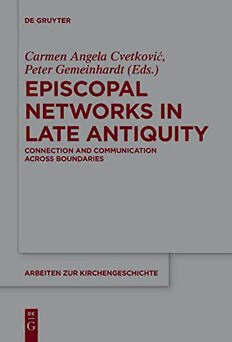
Episcopal Networks in Late Antiquity: Connection and Communication Across Boundaries PDF
Preview Episcopal Networks in Late Antiquity: Connection and Communication Across Boundaries
Episcopal Networks in Late Antiquity Arbeiten zur Kirchengeschichte Founded by Karl Holl † and Hans Lietzmann † Edited by Christian Albrecht and Christoph Markschies Volume 137 Episcopal Networks in Late Antiquity Connection and Communication Across Boundaries Edited by Carmen Angela Cvetković and Peter Gemeinhardt ISBN 978-3-11-055188-4 e-ISBN (PDF) 978-3-11-055339-0 e-ISBN (EPUB) 978-3-11-055251-5 ISSN 1861-5996 Library of Congress Cataloging in Publication Control Number: 2018964953 Bibliographic information published by the Deutsche Nationalbibliothek The Deutsche Nationalbibliothek lists this publication in the Deutsche Nationalbibliografie; detailed bibliographic data are available on the Internet at http://dnb.dnb.de. © 2019 Walter de Gruyter GmbH, Berlin/Boston Printing & binding: CPI books GmbH, Leck www.degruyter.com Table of Contents Abbreviations VII Introduction 1 Part 1: The Ties That Bind Volker Menze Episcopal Nepotism in the Later Roman Empire (c. 350–450) 19 Ariane Bodin A New Approach to Ambrose of Milan’s Kinship 43 Gillian Clark Influential Friends? Augustine’s Episcopal Networks 63 Madalina Toca & Johan Leemans The Authority of a ‘Quasi-Bishop:’ Patronage and Networks in the Letters of Isidore of Pelusium 83 David M. Gwynn Patronage Networks in the Festal Letters of Athanasius of Alexandria 101 Peter Gemeinhardt Bishops as Religious Mentors: Spiritual Education and Pastoral Care 117 Sigrid Mratschek Crossing the Boundaries: Networks and Manifestations of Christian Hospitality 149 Carmen Angela Cvetković Niceta of Remesiana’s Visits to Nola: Between Sacred Travel and Political Mission 179 VI TableofContents Part 2: Episcopal Networks in Context Daniel K. Knox The Impact of the Laurentian Schism on Ennodius of Pavia’s Participation in Episcopal Networks 207 Jamie Wood Building and Breaking Episcopal Networks in Late Antique Hispania 227 Erika Manders Macedonius, Constantius and the Changing Dynamics of Power 249 Jakob Engberg Caring for African Confessors in Exile: The Ministry of Numeria and Candida during the Decian Persecution (Cyprian, Epistulae 21–22) 267 Daniëlle Slootjes The Impact of Geographical and Administrative Boundaries on Late Antique Bishops 295 Andrea Sterk Bishops and Mission Beyond the Frontiers: From Gothia to Nubia 313 List of Contributors 339 Index of Authorsand Texts 343 Index of Ancient Places 357 Index of Modern Authors 361 Abbreviations Abbreviations for journals, series and reference works are given according to Siegfried M. Schwertner,InternationalesAbkürzungsverzeichnisfürTheologieundGrenzgebiete(Berlin,De Gruyter,³2014).WhentheworksofChristianancientworksareabbreviated,theseabbreviations follow Lexikon den antiken christlichen Literatur, eds. Siegmar Döpp/Wilhelm Geerlings (Freiburg:Herder,²1999). https://doi.org/10.1515/9783110553390-001 Introduction RecentstudiesonthedevelopmentofearlyChristianityemphasizetheimportant roleplayedbytheregionalorlocalcontextsinwhatisnowadayscommonlyre- garded as an increasingly fragmented late ancient world. However, despite the political fragmentation of the late Roman Empire, one distinctive feature of the Christianity of this time that needs to be taken more into consideration is its‘inter-connectivity.’¹AsPeterBrownhasobserved,thebasicmoduleofChris- tianityconsistingofabishop,clergy,peopleandaplacetoworshipwasremark- ably stable and easily transferrable to any region.Once established, such basic structures did not develop in isolation but remained closely connected, thus leading to the emergence of a web of Christian belief and practice that spread over much of the later Roman Empire. Both local and trans-regional networks ofinteractioncontributedtotheexpansionofChristianityinthisageoffragmen- tation. The present volume investigates a specific aspect of the ‘inter-connectivity’ that characterizes the late ancient Christianity in the area of the Mediterranean by focusingon the formation and operation of episcopal networks.The gradual rise of the bishop as a key figure of authority in the late antique city has been explained based on multiple converging factors,² such as: an increase in the number of episcopal responsibilities facilitated by the vacuum of local power, welldocumentedthroughouttheRomanempirebeginningwiththethirdcentu- ry; the recognition of the bishop as the highest moral and spiritual authority withinChristiancommunitieswhichrequiredecclesiasticalleaderstosetanex- ample of moral and virtuous conduct to their congregation; the transfer in the bishops’ hands of the management of funds and economic resources.Thus, at a local level, the bishops in their various roles as patrons, teachers, defenders offaith,pastoralcounselors,managersofeconomicresourcesetc.wereexpected to interact with individuals of diverse social background that formed their con- gregations as well as with secular authorities. Totheabovementionedfactors,onemustalsoaddtheofficialrecognitionof ChristianityasreligiolicitaintheRomanEmpirewhichwasfollowedbyanum- berofprivilegesgrantedbyConstantinetobishops,whichstrengthenedtherole Peter Brown, The Rise of Western Christianity:Triumph and Diversity AD 200–1000 (Cam- bridgeMass.:Blackwell,1996)14. RitaLizziTesta,“TheLateAntiqueBishop:ImageandReality,”inACompaniontoLateAn- tiquity,ed.PhilipRousseau(Malden,MA:Wiley-Blackwell,2012)527. https://doi.org/10.1515/9783110553390-002 2 CarmenCvetković,PeterGemeinhardt ofthebishopasamajorpublicfigureofthelateancientcity.³Amongthesepriv- ileges,the permission to travel by imperial post (the cursus publicus usually re- served for imperial officials) in order to attend church synods and councils re- sulted in a marked increase in long-distance communication among church elitescoming fromdifferentgeographical areas and belonging todistincteccle- siastical cultures and theological traditions.The hustle and bustle of ecclesias- tical travel prompted Ammianus Marcellinus’ famous complaint about “the throngsofbishopshasteninghitherandthitheronthepublicposthorsestovar- ious synods.”⁴ Other reasons for long-distance ecclesiastical mobility included, missionary voyages, disciplinary hearings or pilgrimage, a phenomenon that saw anoutstandinggrowthas aresultof Constantine’s ambitiousbuildingpro- gramintheHolyLand.⁵Finally,bishopsalsotravelledagainsttheirwilltomore orlessremotelocationseitherfleeingbarbarianinvasionsorbecauseofimperial banishment.⁶ Theabilityofbishopstointeractatlocallevelwithdifferentsegmentsofthe lateancientsocietyaswellasepiscopallong-distanceinteractionswillbeunder scrutinyinthisvolume.Thepapersassembledhereexplorethenatureandqual- ityofvarioustypesofepiscopalrelationshipsinLateAntiquityattemptingtoun- derstandhowtheywereestablished,cultivatedorputtouseacrosscultural,so- cialorgeographicalboundaries.Thesepapersarerevisedversionsofthelectures presentedataconferencedealingwiththetopicof “EpiscopalNetworksinLate Antiquity: Connection and Communication across Boundaries,” held in Göttin- gen from 28 to 30 September 2016 at the University’s Historical Observatory, andgenerouslyfundedbytheFritzThyssenFoundation.Theconferencebrought together researchersworkinginvariousdisciplines (ancient history,church his- tory,theologyandclassics)andbelongingtodifferentacademictraditions(Brit- ain, Germany, Denmark, France, the United States, Belgium, Switzerland and Hungary).Inadditiontothecontributorstothisvolume,theconferenceincluded also Kate Cooper (London), Julia Hillner (Sheffield), David Lambert (Rome/Ox- ford), Seraina Ruprecht (Bern) and David Natal (London). The meeting offered the opportunity to address a number of questions in order to assess an array of issues regarding the bishops’ rise to or fall from LizziTesta,“TheLateAntiqueBishop,”528. AmmianusMarcellinus,Resgestae21.16.18. See,e.g.,GeorgiaFrank,TheMemoryoftheEyes.PilgrimstoLivingSaintsinChristianLate Antiquity(Berkeley:TheUniversityofCaliforniaPress,2000). ForasurveyofreligioustravelinLateAntiquity,seeBlakeLeyerle,“MobilityandtheTracesof Empire”,inACompaniontoLateAntiquity,ed.PhilipRousseau(Malden,MA:Wiley-Blackwell, 2012)112–113.
